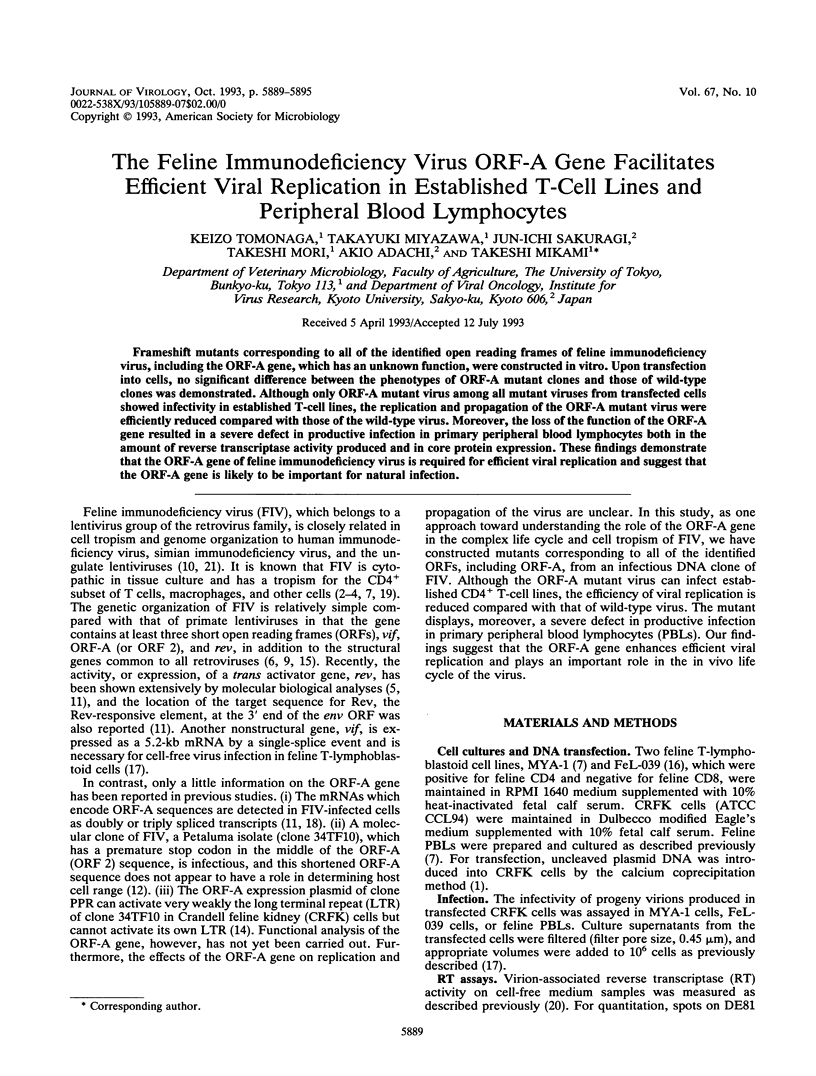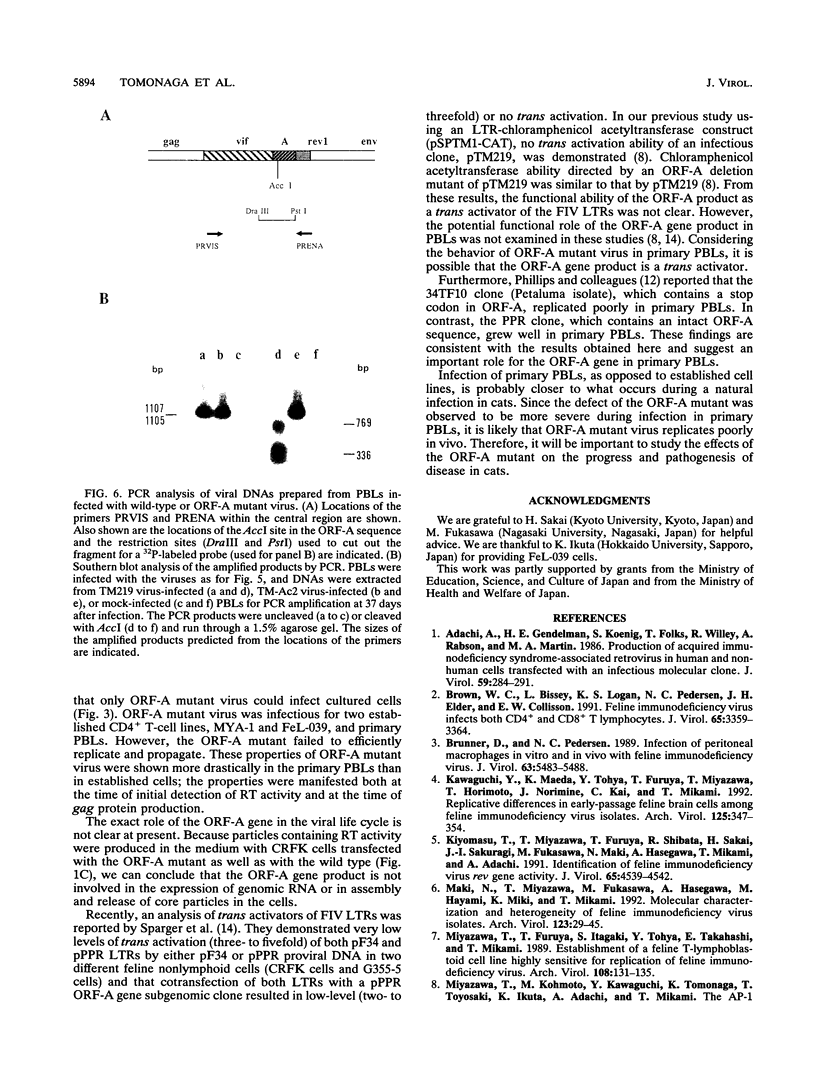Abstract
Frameshift mutants corresponding to all of the identified open reading frames of feline immunodeficiency virus, including the ORF-A gene, which has an unknown function, were constructed in vitro. Upon transfection into cells, no significant difference between the phenotypes of ORF-A mutant clones and those of wild-type clones was demonstrated. Although only ORF-A mutant virus among all mutant viruses from transfected cells showed infectivity in established T-cell lines, the replication and propagation of the ORF-A mutant virus were efficiently reduced compared with those of the wild-type virus. Moreover, the loss of the function of the ORF-A gene resulted in a severe defect in productive infection in primary peripheral blood lymphocytes both in the amount of reverse transcriptase activity produced and in core protein expression. These findings demonstrate that the ORF-A gene of feline immunodeficiency virus is required for efficient viral replication and suggest that the ORF-A gene is likely to be important for natural infection.
Full text
PDF






Images in this article
Selected References
These references are in PubMed. This may not be the complete list of references from this article.
- Adachi A., Gendelman H. E., Koenig S., Folks T., Willey R., Rabson A., Martin M. A. Production of acquired immunodeficiency syndrome-associated retrovirus in human and nonhuman cells transfected with an infectious molecular clone. J Virol. 1986 Aug;59(2):284–291. doi: 10.1128/jvi.59.2.284-291.1986. [DOI] [PMC free article] [PubMed] [Google Scholar]
- Brown W. C., Bissey L., Logan K. S., Pedersen N. C., Elder J. H., Collisson E. W. Feline immunodeficiency virus infects both CD4+ and CD8+ T lymphocytes. J Virol. 1991 Jun;65(6):3359–3364. doi: 10.1128/jvi.65.6.3359-3364.1991. [DOI] [PMC free article] [PubMed] [Google Scholar]
- Brunner D., Pedersen N. C. Infection of peritoneal macrophages in vitro and in vivo with feline immunodeficiency virus. J Virol. 1989 Dec;63(12):5483–5488. doi: 10.1128/jvi.63.12.5483-5488.1989. [DOI] [PMC free article] [PubMed] [Google Scholar]
- Kawaguchi Y., Maeda K., Tohya Y., Furuya T., Miyazawa T., Horimoto T., Norimine J., Kai C., Mikami T. Replicative difference in early-passage feline brain cells among feline immunodeficiency virus isolates. Arch Virol. 1992;125(1-4):347–354. doi: 10.1007/BF01309653. [DOI] [PubMed] [Google Scholar]
- Kiyomasu T., Miyazawa T., Furuya T., Shibata R., Sakai H., Sakuragi J., Fukasawa M., Maki N., Hasegawa A., Mikami T. Identification of feline immunodeficiency virus rev gene activity. J Virol. 1991 Aug;65(8):4539–4542. doi: 10.1128/jvi.65.8.4539-4542.1991. [DOI] [PMC free article] [PubMed] [Google Scholar]
- Maki N., Miyazawa T., Fukasawa M., Hasegawa A., Hayami M., Miki K., Mikami T. Molecular characterization and heterogeneity of feline immunodeficiency virus isolates. Arch Virol. 1992;123(1-2):29–45. doi: 10.1007/BF01317136. [DOI] [PubMed] [Google Scholar]
- Miyazawa T., Furuya T., Itagaki S., Tohya Y., Takahashi E., Mikami T. Establishment of a feline T-lymphoblastoid cell line highly sensitive for replication of feline immunodeficiency virus. Arch Virol. 1989;108(1-2):131–135. doi: 10.1007/BF01313750. [DOI] [PubMed] [Google Scholar]
- Olmsted R. A., Hirsch V. M., Purcell R. H., Johnson P. R. Nucleotide sequence analysis of feline immunodeficiency virus: genome organization and relationship to other lentiviruses. Proc Natl Acad Sci U S A. 1989 Oct;86(20):8088–8092. doi: 10.1073/pnas.86.20.8088. [DOI] [PMC free article] [PubMed] [Google Scholar]
- Pedersen N. C., Ho E. W., Brown M. L., Yamamoto J. K. Isolation of a T-lymphotropic virus from domestic cats with an immunodeficiency-like syndrome. Science. 1987 Feb 13;235(4790):790–793. doi: 10.1126/science.3643650. [DOI] [PubMed] [Google Scholar]
- Phillips T. R., Lamont C., Konings D. A., Shacklett B. L., Hamson C. A., Luciw P. A., Elder J. H. Identification of the Rev transactivation and Rev-responsive elements of feline immunodeficiency virus. J Virol. 1992 Sep;66(9):5464–5471. doi: 10.1128/jvi.66.9.5464-5471.1992. [DOI] [PMC free article] [PubMed] [Google Scholar]
- Phillips T. R., Talbott R. L., Lamont C., Muir S., Lovelace K., Elder J. H. Comparison of two host cell range variants of feline immunodeficiency virus. J Virol. 1990 Oct;64(10):4605–4613. doi: 10.1128/jvi.64.10.4605-4613.1990. [DOI] [PMC free article] [PubMed] [Google Scholar]
- Saiki R. K., Gelfand D. H., Stoffel S., Scharf S. J., Higuchi R., Horn G. T., Mullis K. B., Erlich H. A. Primer-directed enzymatic amplification of DNA with a thermostable DNA polymerase. Science. 1988 Jan 29;239(4839):487–491. doi: 10.1126/science.2448875. [DOI] [PubMed] [Google Scholar]
- Sparger E. E., Shacklett B. L., Renshaw-Gegg L., Barry P. A., Pedersen N. C., Elder J. H., Luciw P. A. Regulation of gene expression directed by the long terminal repeat of the feline immunodeficiency virus. Virology. 1992 Mar;187(1):165–177. doi: 10.1016/0042-6822(92)90305-9. [DOI] [PubMed] [Google Scholar]
- Talbott R. L., Sparger E. E., Lovelace K. M., Fitch W. M., Pedersen N. C., Luciw P. A., Elder J. H. Nucleotide sequence and genomic organization of feline immunodeficiency virus. Proc Natl Acad Sci U S A. 1989 Aug;86(15):5743–5747. doi: 10.1073/pnas.86.15.5743. [DOI] [PMC free article] [PubMed] [Google Scholar]
- Tokunaga K., Nishino Y., Oikawa H., Ishihara C., Mikami T., Ikuta K. Altered cell tropism and cytopathicity of feline immunodeficiency viruses in two different feline CD4-positive, CD8-negative cell lines. J Virol. 1992 Jun;66(6):3893–3898. doi: 10.1128/jvi.66.6.3893-3898.1992. [DOI] [PMC free article] [PubMed] [Google Scholar]
- Tomonaga K., Norimine J., Shin Y. S., Fukasawa M., Miyazawa T., Adachi A., Toyosaki T., Kawaguchi Y., Kai C., Mikami T. Identification of a feline immunodeficiency virus gene which is essential for cell-free virus infectivity. J Virol. 1992 Oct;66(10):6181–6185. doi: 10.1128/jvi.66.10.6181-6185.1992. [DOI] [PMC free article] [PubMed] [Google Scholar]
- Toyosaki T., Miyazawa T., Furuya T., Tomonaga K., Shin Y. S., Okita M., Kawaguchi Y., Kai C., Mori S., Mikami T. Localization of the viral antigen of feline immunodeficiency virus in the lymph nodes of cats at the early stage of infection. Arch Virol. 1993;131(3-4):335–347. doi: 10.1007/BF01378636. [DOI] [PubMed] [Google Scholar]
- Willey R. L., Smith D. H., Lasky L. A., Theodore T. S., Earl P. L., Moss B., Capon D. J., Martin M. A. In vitro mutagenesis identifies a region within the envelope gene of the human immunodeficiency virus that is critical for infectivity. J Virol. 1988 Jan;62(1):139–147. doi: 10.1128/jvi.62.1.139-147.1988. [DOI] [PMC free article] [PubMed] [Google Scholar]
- Yamamoto J. K., Sparger E., Ho E. W., Andersen P. R., O'Connor T. P., Mandell C. P., Lowenstine L., Munn R., Pedersen N. C. Pathogenesis of experimentally induced feline immunodeficiency virus infection in cats. Am J Vet Res. 1988 Aug;49(8):1246–1258. [PubMed] [Google Scholar]







